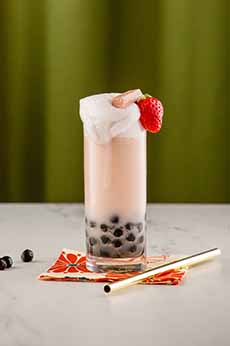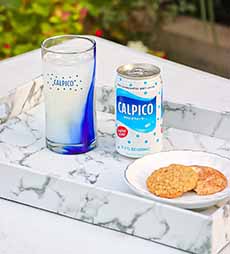Bubble Tea Cocktail Recipe For National Bubble Tea Day
|
We couldn’t make this bubble tea cocktail in time for National Bubble Tea Day, April 30th. But by the time this weekend rolled around, we managed to acquire the boba (the tapioca pearls that make bubble tea) and made the sake simple syrup to put together the cocktail. As a fan of bubble tea, we were excited to try an alcoholic version, so we thank the mixologists at Kikori Whiskey for the recipe. Kikori is a smooth rice whiskey made with locally grown rice, distilled, aged, blended and bottled in Kumamoto, Japan. The light, balanced notes of Kikori whiskey add a rich flavor to the creamy and fruity profile of this tasty cocktail, made fun with the addition of boba. Boba are tapioca pearls—the bubbles in bubble tea. They have a chewy, fun, gummy texture and can be used not just in bubble tea and related cocktails, but in iced coffee, milk, smoothies and other cold drinks; and as toppings for ice cream, pudding and other desserts; even as a topping for pancakes. You’ll need to gather specialty ingredients for this cocktail (photo #1). You can get the boba (tapioca pearls) and the Calpico / Calpis soft drink online (see photo #5 and its caption), a Japanese non-carbonated soft drink that is light, somewhat milky. It’s similar to plain or vanilla-flavored yogurt or Yakult†, which you can substitute. It is available on Amazon; and here’s a recipe to make your own. We actually substituted Lifeway kefir. We also had an open bottle of nigori (cloudy) sake, and used it rather than purchase a bottle of the possibly more elegant sayuri nigori sake. Since it was being sweetened with sugar, we opined that the difference wouldn’t be noticeable. Note that when buying boba, look for the instant variety; otherwise, you’ll have to cook them for 12-15 minutes. It’s important that you properly store the boba, so they don’t lose their flavor and chewy texture. Here’s more about working with boba. Ingredients Per Drink Mix until dissolved: 1. MAKE the sake syrup. If you are making several drinks, multiply the amount specified above. 2. ADD the boba to the bottom of a tall glass. 3. MUDDLE the strawberries thoroughly in the bottom of a shaker. Add the Kikori, sake syrup, lemon juice, coconut milk and egg white. 4. ADD the ice to the shaker and shake vigorously. 5. Strain through a double strainer, throw away the ice and then pour back the drink into the shaker. Vigorously re-shake without ice for another minute or two. 6. POUR the contents into the glass over the boba and let them sit for ten seconds. 7. SLOWLY POUR the Calpico soft drink into the center of the cocktail to create the foam on top. 8. GARNISH the glass rim with a notched strawberry. Serve with wide boba straws or a long spoon to scoop up the boba. > THE HISTORY OF SAKE Kikori Whiskey is a smooth, 100% rice whiskey made in Japan with rice that’s grown in ancient rice paddies in Kumamoto Prefecture (the same region made famous in the U.S. for its Kumamoto oysters). Whiskey made from rice is as distinctive in its own way as whiskey made from corn (like Bourbon) to whiskey made from malted barley wheat blends (Scotch, Irish whiskey) or rye (such as Jack Daniels). Kikori is distilled to 82 proof and aged in American oak, French Limousin and sherry barrels, anywhere from three to ten years. It is blended and bottled, all in Kumamoto, Japan. As a result of its base of white rice, the whiskey is lighter in color than those made from other grains. But that doesn’t mean it lacks punch and flavor: There are plenty in this nuanced spirit. You can enjoy Kikori straight, in a classic cocktail or in an Asian fusion drink. You can even enjoy it with shellfish, in raw or cooked dishes. Kikora won a gold metal at the 2016 San Francisco World Spirits Competition. Its logo is a woodsman from a Japanese folktale that urges people to find balance in their lives. |
|
|
|
________________ *Most boba are sold dehydrated, and need to be rehydrated. †Yakult is a probiotic, cultured dairy beverage, similar to kefir and other yogurt-based beverages but made with a different bacteria culture. It has a citrus flavor (it contains flavorings and sugar). ‡Nigormeans “cloudy sake” in Japanese. It is a style rather than a classification; there is a wide range of textures and sweetness among nigori sakes. The cloudiness comes from rice solids (the lees) suspended in the sake. Nigori is technically not unfiltered. Rather, it is coarsely pressed (sake undergoes both pressing and filtration). Sayuri, which means “little lily” in Japanese, is a style of soft, floral-note nigori with hints of white grape and cherry blossom. We like to pair nigori sake with spicy foods, sushi and raw seafood (clams, oysters, scallops, etc.), and chocolate desserts.
|
||







